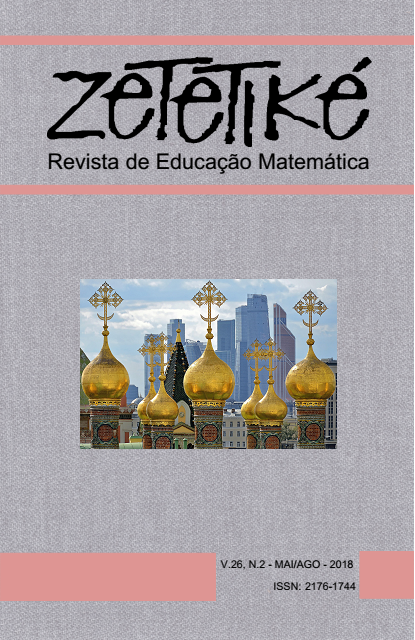Abstract
In this article we discuss the construction of conceptual knowledge of rational numbers by basic education
students in grades 3 and 4 as an integrated process with a focus on percentage. At an early stage of learning
rational numbers, we aim to know what understanding students develop of the relational nature of percentage
and how percentage contributes to this learning, considering an understanding of the relations among different
rational number representations. This study is based on a teaching-learning experience, following a design based
research methodology. Data was collected through participant observation, supported in a logbook, with audio
and video recordings of the lessons and we analyze the dialogues and the productions of the students of a class.
The results show that the students display an understanding of the relational nature of percentage and that the grasp of relationships and concepts involved in this notion contributes to building an understanding of the
multiplicative nature of rational numbers.
References
Behr, M., Lesh, R., Post, T., & Silver, E. (1983). Rational number concepts. In R. Lesh & M. Landau (Eds.), Acquisition of mathematics concepts and processes (pp. 91–126). New York, NY: Academic Press.
Behr, M. J., Lesh, R., & Post, T. (1981, April). Rational number ideas and the role of representational systems. Paper presented at the Annual Meeting of the American Educational Research Association, Los Angeles, USA.
Bruner, J. (1996). Cultura da educação. Lisboa: Edições 70.
Cobb, P., Stephan, M., McClain, K., & Gravemeijer, K. (2001). Participating in classroom mathematical practices. In E. Yackel, K. Gravemeijer & A. Sfard (Eds.), A journey in mathematics education research: Insights from the work of Paul Cobb (pp. 117–163). New York, NY: Springer.
De Corte, E., Depaepe, F., Op’t Eynde, P., & Verschaffel, L. (2005, January). Comparing mathematics education traditions in four European countries: The case of the teaching of percentages in the primary school. Paper presented at the meeting of Universiti Teknologi Malaysia, Malaysia.
Dreyfus, T. (1999). Why Johnny can’t prove. In D. Tirosh (Ed.), Forms of mathematical knowledge (pp. 85–109). Dordrecht: Springer.
Freudenthal, H. (1968). Why to teach mathematics so as to be useful. Educational Studies in Mathematics, 1(1), 3–8.
Goetz, J. P., & LeCompte, M. D. (1984). Ethnography and qualitative design in educational research. New York, NY: Academic Press.
Goldin, G. A., & Kaput, J. J. (1996). A joint perspective on the idea of representation in learning and doing mathematics. In L. Steffe, P. Nesher, P. Cobb, G. A. Goldin, & B. Greer (Eds.), Theories of mathematical learning (pp. 397–430). Hillsdale, NJ: Eribaum.
Gravemeijer, K., & Cobb, P. (2006). Design research from the learning design perspective. In van den Akker, K. Gravemeijer, S. McKenney, & N. Nieveen (Eds.), Educational Design Research (pp. 45–85). London: Routledge.
Hiebert, J., & Lefevre, P. (1986). Conceptual and procedural knowledge in mathematics: An introductory analysis. In J. Hiebert (Ed.), Conceptual and procedural knowledge: The case of mathematics (pp. 1-27). Hillsdale, NJ: Erlbaum.
Hiebert, J., Wearne, D., & Taber, S. (1991). Fourth graders' gradual construction of decimal fractions during instruction using different physical representations. The Elementary School Journal, 91(4), 321–341.
Lamon, S. (2007) Rational numbers and proportional reasoning. In F. Lester (Ed), Second handbook of mathematics teaching and learning (pp. 629–667). Greenwich, CT: Information Age.
Leinhardt, G. (1988). Getting to know: Tracing students’ mathematical knowledge from intuition to competence. Educational Psychologist, 23(2), 119–144.
Lembke, L. O, & Reys, B. J. (1994). The development of, and interaction between, intuitive and school-taught ideas about percent. Journal for Research in Mathematics Education, 25(3), 237–259.
Moss, J. (2002). Percents and proportion at the center: Altering the teaching sequence for rational number. In B. Littweiller (Ed.), Making sense of fractions, ratios, and proportions (pp. 109–120). Reston, VA: National Council of Teachers of Mathematics.
Moss, J., & Case, R. (1999). Developing children’s understanding of the rational numbers: A new model and an experimental curriculum. Journal for Research in Mathematics Education, 30(2), 122–147.
NCTM (2000). Principles and standards for school mathematics. Reston, VA: National Council of Teachers of Mathematics.
Parker, M. (2004). Reasoning and working proportionally with percent. Mathematics Teaching in the Middle School, 9(6), 326–330.
Parker, M., & Leinhardt, G. (1995). Percent: A privileged proportion. Review of Educational Research, 65(4), 421–481.
Ponte, J. P. (2005). Gestão Curricular em Matemática. In GTI (Ed..), O professor e o desenvolvimento curricular (pp.11–34). Lisboa: APM.
Ponte, J. P., Carvalho, R., Mata-Pereira, J., & Quaresma, M. (2016). Investigação baseada em design para compreender e melhorar as práticas educativas. Quadrante, 25(2), 77–98.
Ponte, J. P., & Serrazina, M. L. (2000). Didáctica da Matemática do 1.º ciclo. Lisboa: Universidade Aberta.
Serrazina, M. L. (2012). O sentido do número no 1º ciclo: Uma leitura de investigação. Boletim Gepem, 61, 15–28.
Siegler, R. S. (2016). Magnitude knowledge: The common core of numerical development. Developmental Science, 19(3), 341–361.
Siegler, R. S., Fazio, L. K., Bailey, D. H., & Zhou, X. (2013). Fractions: The new frontier for theories of numerical development. Trends in Cognitive Sciences, 17(1), 13–19.
Siegler, R. S., Thompson, C. A., & Schneider, M. (2011). An integrated theory of whole number and fractions development. Cognitive Psychology, 62(4), 273–296.
Tian, J., & Siegler, R. S. (2017). Which type of rational numbers should students learn first?. Educational Psychology Review, 1–22.
Van den Heuvel-Panhuizen, M. (2003). The didactical use of models in realistic mathematics education: An example from a longitudinal trajectory on percentage. Educational Studies in Mathematics, 54(1), 9–35.
Van Galen, F., Feijs, E., Figueiredo, N., Gravemeijer, K., Herpen, E., & Keijzer, R. (2008). Fractions, percentages, decimals and proportions: A learning-teaching trajectory for grade 4, 5 and 6. Rotterdam: Sense.
Van Galen, F., & Van Eerde, D. (2013). Solving problems with the percentage bar. Indonesian Mathematical Society Journal on Mathematics Education, 4(1), 1–8.

This work is licensed under a Creative Commons Attribution-NonCommercial-NoDerivatives 4.0 International License.
Copyright (c) 2018 Zetetike


